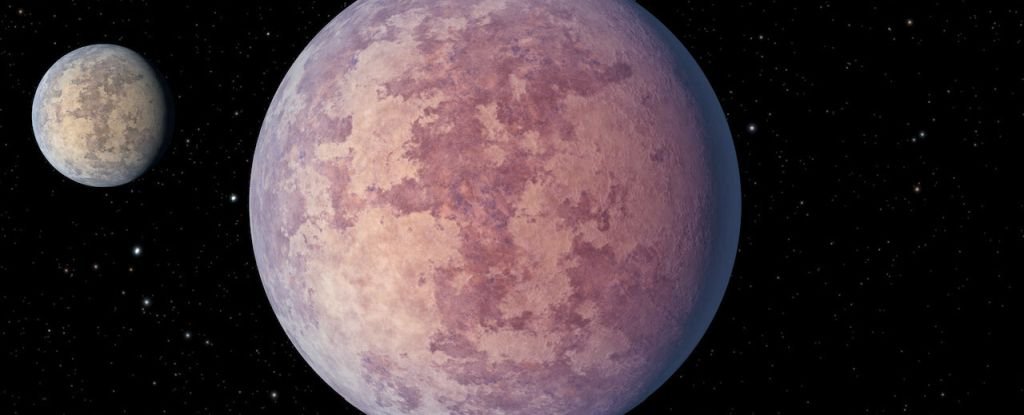Products You May Like
Two new worlds of probable rocky mineral goodness have just been found orbiting a star close to our own cosmic neighborhood.
The two newly discovered exoplanets are what are known as super-Earths – bigger than Earth, but smaller than an ice giant – orbiting a cool red dwarf star called HD 260655, which is just 33 light-years away.
While the worlds are unlikely to be habitable, given our current understanding of life, the star and its exoplanets are among the closest multi-world systems to Earth.
This makes it an excellent target for follow-up surveys to try to understand what the exoplanets are made of, and to assess their atmospheres – an endeavor that will aid our search for extraterrestrial life, even if the two worlds turn out to be incapable of hosting it themselves.
“Both planets in this system are each considered among the best targets for atmospheric study because of the brightness of their star,” says astronomer Michelle Kunimoto of MIT’s Kavli Institute for Astrophysics and Space Research.
“Is there a volatile-rich atmosphere around these planets? And are there signs of water or carbon-based species? These planets are fantastic test beds for those explorations.”
To date, more than 5,000 exoplanets have been confirmed in the Milky Way, and astrobiologists are deeply interested in finding terrestrial, or rocky, worlds like Earth, Venus, and Mars.
We have a sample size of exactly one world known to host life – ours – so finding planets similar to Earth in size and composition is one of the top criteria in the search for life elsewhere in the galaxy.
Rocky exoplanets, however, are relatively small in both size and mass, which makes them harder to detect; most of the exoplanets we’ve been able to measure to date tend to fall into the giant category. Rocky worlds – and better yet, nearby rocky worlds – are highly sought.
The two worlds orbiting HD 260655 – named HD 260655 b and HD 260655 c – were discovered because they pass between us and their star during their orbit. The faint dips in starlight due to these exoplanetary transits were recorded by NASA’s exoplanet-hunting telescope TESS, which is designed to detect exactly such phenomena.
When Kunimoto spotted these transit dips in the TESS data, the next step was to look to see if the star had appeared in previous surveys – and it had.
The High Resolution Echelle Spectrometer on the Keck Telescope (now known as ANDES) had publicly available data going back to 1998. Another spectrometer, CARMENES at the Calar Alto Observatory in Spain, also had recorded the star.
This makes a huge difference to exoplanet science: Spectrographic data can reveal whether or not a star is moving on the spot.
“Every planet orbiting a star is going to have a little gravitational pull on its star,” Kunimoto says. “What we’re looking for is any slight movement of that star that could indicate a planetary-mass object is tugging on it.”
Between the TESS data and the data from HIRES and CARMENES, the team was able to confirm that two exoplanets were orbiting HD 260655. Moreover, with both sets of data, the team was able to compile a comprehensive profile of the two exoplanets.
Transit data provides a physical size, based on how much light is blocked from the star; and spectral data reveals how massive the exoplanet is, based on how much the star moves. Both sets of data can be used to calculate the exoplanet’s orbit.
The inner exoplanet, HD 260655 b, is around 1.2 times the size of Earth and twice the mass of Earth, and orbits the star every 2.8 days. The outer world, HD 260655 c, is 1.5 times the size and thrice the mass of Earth, and has a 5.7-day orbit.
At those sizes and masses, their densities suggest that the two exoplanets are likely to be rocky worlds.
Sadly, even though the star is cooler and dimmer than the Sun, the proximity of the planets to HD 260655 means the worlds would be way too hot for life as we know it. HD 260655 b has an average temperature of 435 degrees Celsius (816 Fahrenheit), and HD 260655 c is a milder but still scorching 284 degrees Celsius (543 degrees Fahrenheit).
“We consider that range outside the habitable zone, too hot for liquid water to exist on the surface,” Kunimoto says.
However, both exoplanets could still have atmospheres, which should be ripe for probing by the newly deployed James Webb Space Telescope, which includes peering at exoplanet atmospheres among its mission objectives.
What’s more, there could even be additional exoplanets orbiting the star that we haven’t discovered yet.
“There are many multi-planet systems hosting five or six planets, especially around small stars like this one,” says astrophysicist Avi Shporer of MIT’s Kavli Institute for Astrophysics and Space Research.
“Hopefully we will find more, and one might be in the habitable zone. That’s optimistic thinking.”
The team presented its findings at the 240th meeting of the American Astronomical Society.
